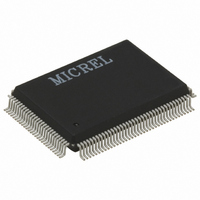KSZ8995X Micrel Inc, KSZ8995X Datasheet - Page 19

KSZ8995X
Manufacturer Part Number
KSZ8995X
Description
5 Port 10/100 Switch With PHY And Frame Buffers
Manufacturer
Micrel Inc
Specifications of KSZ8995X
Applications
*
Mounting Type
Surface Mount
Package / Case
128-MQFP, 128-PQFP
Number Of Primary Switch Ports
5
Internal Memory Buffer Size
64
Operating Supply Voltage (typ)
1.8/2.5/3.3V
Fiber Support
Yes
Integrated Led Drivers
Yes
Phy/transceiver Interface
MII/SNI
Power Supply Type
Analog/Digital
Package Type
PQFP
Data Rate (typ)
10/100Mbps
Vlan Support
Yes
Operating Temperature (max)
70C
Operating Temperature (min)
0C
Pin Count
128
Mounting
Surface Mount
Jtag Support
No
Operating Temperature Classification
Commercial
Lead Free Status / RoHS Status
Lead free / RoHS Compliant
For Use With
576-1642 - BOARD EVALUATION FOR KSZ8995XA
Lead Free Status / RoHS Status
Compliant, Lead free / RoHS Compliant
Other names
576-1041
Available stocks
Company
Part Number
Manufacturer
Quantity
Price
Company:
Part Number:
KSZ8995X
Manufacturer:
KENDIN
Quantity:
8
Company:
Part Number:
KSZ8995XA
Manufacturer:
MICREL
Quantity:
1 334
Company:
Part Number:
KSZ8995XA
Manufacturer:
MICREL30
Quantity:
348
Part Number:
KSZ8995XA
Manufacturer:
MICREL
Quantity:
20 000
KS8995X
Micrel
Introduction
The KS8995X contains five 10/100 physical layer transceivers and five MAC (Media Access Control) units with an integrated
layer 2 switch. The device runs in three modes. The first mode is as a five-port integrated switch. The second is as a five-port
switch with the fifth port decoupled from the physical port. In this mode access to the fifth MAC is provided through an MII (Media
Independent Interface). This is useful for implementing an integrated broadband router. The third mode uses the dual MII
feature to recover the use of the fifth PHY. This allows the additional broadband gateway configuration, where the fifth PHY
may be accessed through the MII-P5 port.
The KS8995X is optimized for an unmanaged design in which the configuration is achieved through I/O strapping or EEPROM
programming at system reset time.
On the media side, the KS8995X supports IEEE 802.3 10BaseT, 100BaseTX on all ports, and 100BaseFX on ports 4 and 5.
The KS8995X can be used as two separate media converters.
Physical signal transmission and reception are enhanced through the use of patented analog circuitry that makes the design
more efficient and allows for lower power consumption and smaller chip die size.
The major enhancements from the KS8995E to the KS8995X are support for programmable rate limiting, a dual MII interface,
MDC/MDIO control interface for IEEE 802.3-defined register configuration (not all the registers), per-port broadcast storm
protection, local loopback and lower power consumption.
The KS8995X is pin-compatible to the managed switch, the KS8995M.
Functional Overview: Physical Layer Transceiver
100BaseTX Transmit
The 100BaseTX transmit function performs parallel-to-serial conversion, 4B/5B coding, scrambling, NRZ-to-NRZI conversion,
MLT3 encoding and transmission. The circuit starts with a parallel-to-serial conversion, which converts the MII data from the
MAC into a 125MHz serial bit stream. The data and control stream is then converted into 4B/5B coding followed by a scrambler.
The serialized data is further converted from NRZ to NRZI format, and then transmitted in MLT3 current output. The output
current is set by an external 1% 3.01k resistor for the 1:1 transformer ratio. It has a typical rise/fall time of 4ns and complies
with the ANSI TP-PMD standard regarding amplitude balance, overshoot and timing jitter. The wave-shaped 10BaseT output
is also incorporated into the 100BaseTX transmitter.
100BaseTX Receive
The 100BaseTX receiver function performs adaptive equalization, DC restoration, MLT3-to-NRZI conversion, data and clock
recovery, NRZI-to-NRZ conversion, de-scrambling, 4B/5B decoding and serial-to-parallel conversion. The receiving side
starts with the equalization filter to compensate for inter-symbol interference (ISI) over the twisted pair cable. Since the
amplitude loss and phase distortion is a function of the length of the cable, the equalizer has to adjust its characteristics to
optimize the performance. In this design, the variable equalizer will make an initial estimation based on comparisons of
incoming signal strength against some known cable characteristics, then it tunes itself for optimization. This is an ongoing
process and can self adjust against environmental changes such as temperature variations.
The equalized signal then goes through a DC restoration and data conversion block. The DC restoration circuit is used to
compensate for the effect of baseline wander and improve the dynamic range. The differential data conversion circuit converts
the MLT3 format back to NRZI. The slicing threshold is also adaptive.
The clock recovery circuit extracts the 125MHz clock from the edges of the NRZI signal. This recovered clock is then used to
convert the NRZI signal into the NRZ format. The signal is then sent through the de-scrambler followed by the 4B/5B decoder.
Finally, the NRZ serial data is converted to the MII format and provided as the input data to the MAC.
PLL Clock Synthesizer
The KS8995X generates 125MHz, 42MHz, 25MHz and 10MHz clocks for system timing. Internal clocks are generated from
an external 25MHz crystal.
Scrambler/De-Scrambler (100BaseTX only)
The purpose of the scrambler is to spread the power spectrum of the signal in order to reduce EMI and baseline wander. The
data is scrambled through the use of an 11-bit wide linear feedback shift register (LFSR). This can generate a 2047-bit non-
repetitive sequence. The receiver will then de-scramble the incoming data stream with the same sequence at the transmitter.
100BaseFX Operation
100BaseFX operation is very similar to 100BaseTX operation except that the scrambler/de-scrambler and MLT3 encoder/
decoder are bypassed on transmission and reception. In this mode the auto-negotiation feature is bypassed since there is no
standard that supports fiber auto-negotiation.
December 2003
19
M9999-120403












